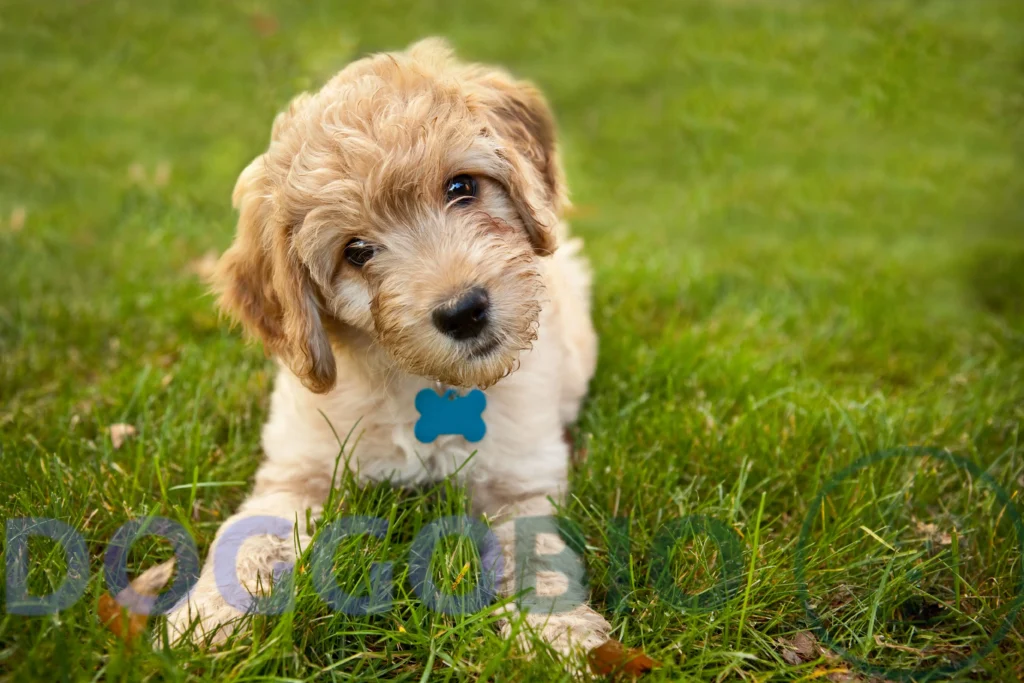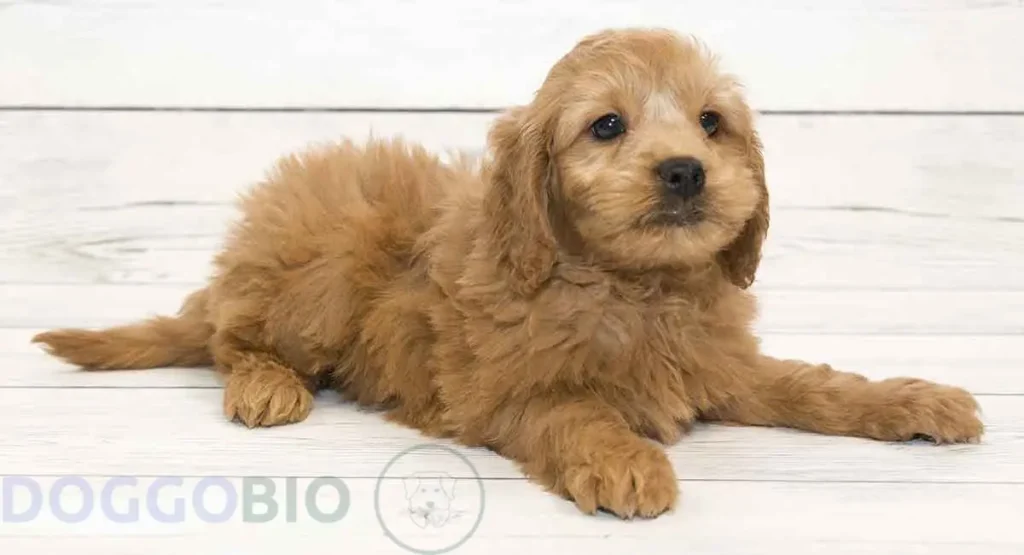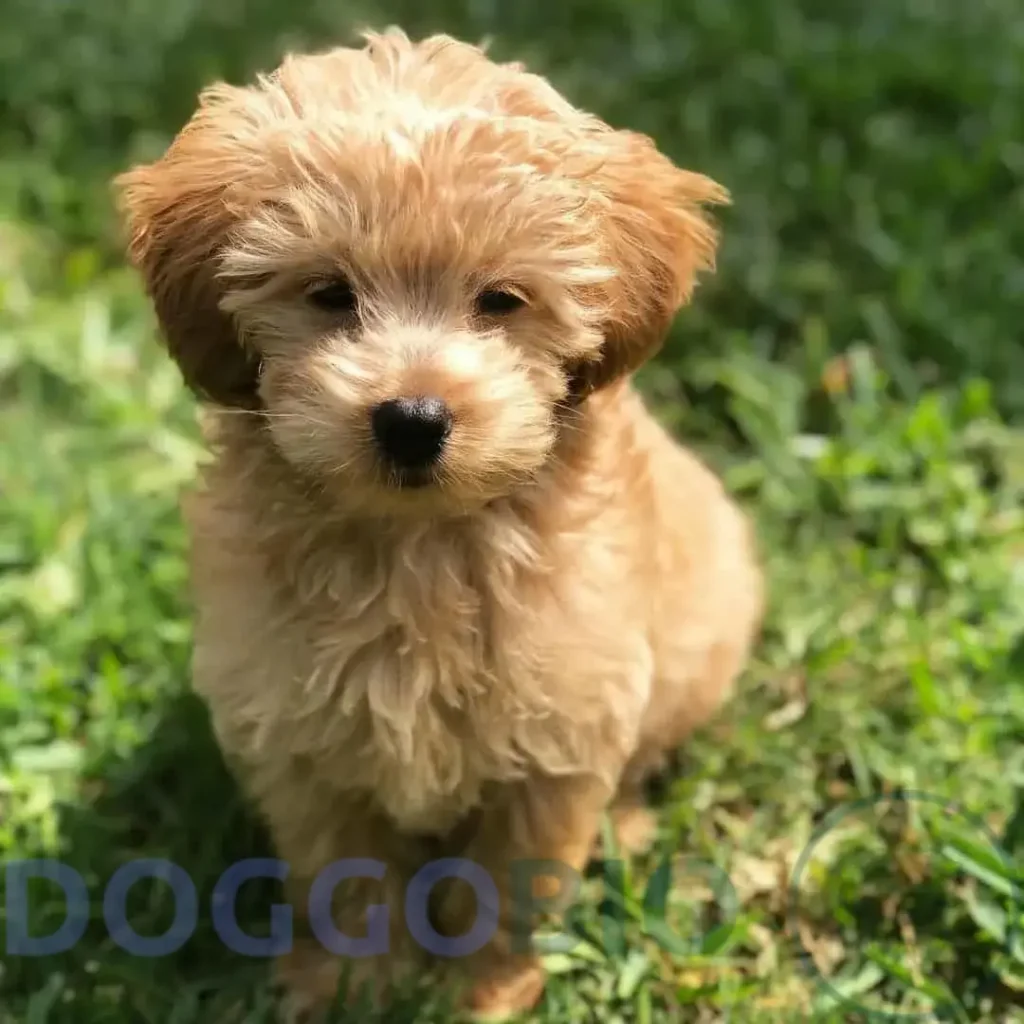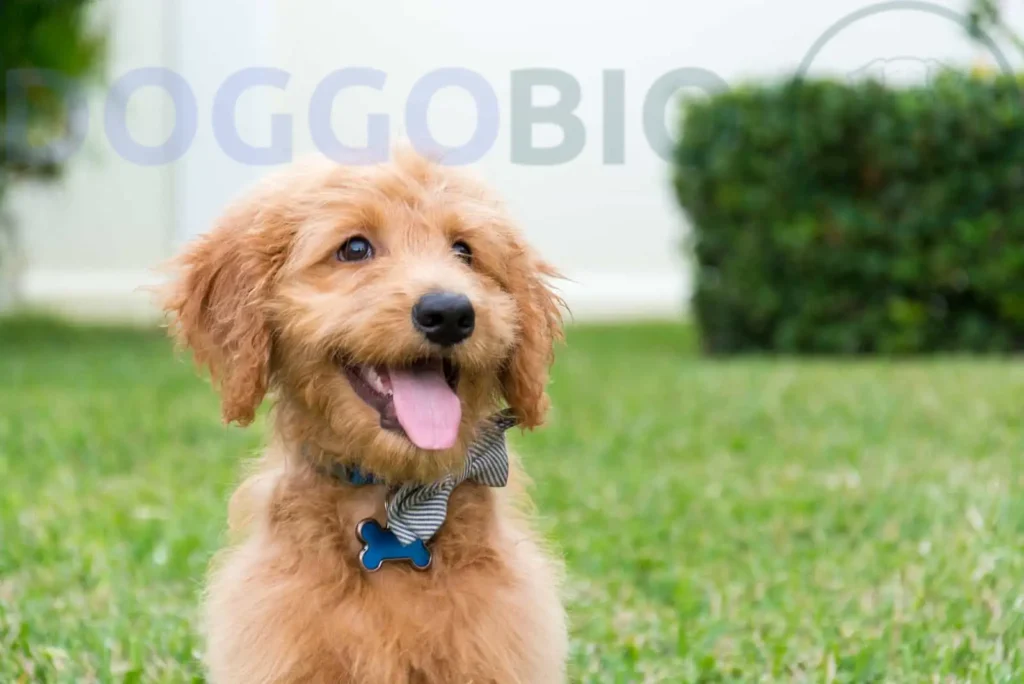The Teacup Goldendoodle, a captivating and endearing canine companion, has captured the hearts of dog lovers worldwide.
This delightful breed is a cross between a Golden Retriever and a Toy or Miniature Poodle, resulting in an enchanting combination of intelligence, playfulness, and affection.
Known for their miniature size and adorable appearance, Teacup Goldendoodles have quickly gained popularity among those seeking a smaller yet equally lovable version of the beloved Goldendoodle.
This article will discover why they are cherished companions for individuals and families alike.
A Brief Overview of Micro Goldendoodle
| Size | 8 to 13 inches (20.3cm to 33cm) |
| Weight | 7 to 10 pounds (3.2kg to 4.5kg) |
| Temperament | Gentle, loving and sweet |
| Exercise Requirements | 30 minutes per day |
| Lifespan | 7 to 10 years |
| Coat | Wavy or curly single coat |
| Shedding | Low |
| Apartment Adaptability | Can comfortably live in an apartment |
What is Teacup Goldendoodle?

The Teacup Goldendoodle, also known as the Teacup Mini Goldendoodle or Mini Teacup Goldendoodle, is a carefully bred multigenerational crossbreed. They are created by breeding a Mini F1 Goldendoodle with a Toy Poodle, resulting in the most minor and hypoallergenic Goldendoodle variation.
Teacup Goldendoodles are typically F1bb mixes, which means they are 88% Poodle. These adorable pups can weigh as little as 7 pounds and are significantly smaller than Toy Goldendoodles.
The great news is that Teacup Goldendoodles are generally healthier than other teacup breeds like Teacup Morkies, Teacup Yorkies, Teacup Maltese, and Toy Bulldogs. These other teacups often result from breeding the most miniature dogs in a litter (runts) or from dwarfism, which increases the risk of diseases. In contrast, Teacup Goldendoodles are primarily the result of crossbreeding with tiny Toy Poodles.
History of Teacup Groodle
The Teacup Groodle, also known as the Teacup Goldendoodle, emerged from the designer dog trend that gained popularity in the 1990s. It all started with the Labradoodle, a mix of Poodle and Labrador Retriever, and remains one of the most popular designer breeds today. The concept of creating mixed-breed dogs, notably smaller versions of popular breeds, took off during this time.
Wally Conron, the breeding manager for the Royal Guide Dog Association of Australia, is credited with creating the first Labradoodle in the 1990s. His goal was to develop a hypoallergenic guide dog with the desirable traits of both breeds. This breakthrough sparked a surge in the popularity of Doodle mixes, with the Poodle’s low-shedding coat being a significant attraction.
Both parent breeds of the Teacup Groodle have long histories and origins. Originally from Germany, poodles were bred for water bird retrieval, leading to their athletic build, intelligence, and curly coat. As their name suggests, Golden Retrievers originated in Scotland and were bred for retrieving game birds.
Goldendoodle Generations Explained
Goldendoodles come in various generations, including the Teacup Goldendoodle. Here’s a breakdown of each generation:
| 1st Parent | 2nd Parent | % Poodle* | % Golden Retriever* | |
| Goldendoodle (F1) | Golden Retriever | Poodle | 50% | 50% |
| Goldendoodle (F1B) | F1 Goldendoodle | Poodle | 75% | 25% |
| Goldendoodle (F1BB) | F1B Goldendoodle | Poodle | 87.5% | 12.5% |
| Goldendoodle (F2) | F1 Goldendoodle | F1 Goldendoodle | 50% | 50% |
| Goldendoodle (F2B) | F1 Goldendoodle | F1B Goldendoodle | 62.5% | 37.5% |
| Goldendoodle (F2B alt) | F2 Goldendoodle | Poodle | 25% | 25% |
| Goldendoodle (F3/Multigen) | F1B Goldendoodle or higher | F1B Goldendoodle or higher | Varies | Varies |
Teacup Goldendoodles are often not first-generation mixes due to health considerations. Breeders specializing in smaller Teacup and Mini Goldendoodles usually cross F1, F1b, F2, or F2b Mini Goldendoodles with Toy Poodles for more predictable results in size and other characteristics.
The controversy around breeding Pocket Goldendoodle
The popularity of Teacup Goldendoodles has raised ethical concerns due to the breeding practices involved in achieving the teacup size. Unscrupulous breeders often breed runts of the litter to produce abnormally small puppies, leading to potential health issues.
These puppies may suffer from severe conditions, including heart problems and genetic defects. The unhealthy breeding practices and lack of proper care in unethical breeders and puppy mills can result in stunted growth and malnutrition, leading to health complications.
Some breeders even use dogs with the dwarfism gene, which can introduce a range of health problems, such as:
- Hormonal issues,
- Hypothyroidism,
- Reproductive system complications,
- Skeletal problems,
- And the difficulty with movement and breathing.
What Does a Teacup Goldendoodle Look Like?
Teacup Goldendoodles exhibit a combination of physical traits from Golden Retrievers and Poodles. Still, their appearance tends to lean towards the Poodle side due to their higher percentage of Toy Poodle ancestry.
- They have a soft, medium to long-length coat that is wavy or curly in texture.
- Regarding body structure, Teacup Goldendoodles have a sturdy yet compact build with well-proportioned and balanced features.
- They usually have a straight back, a deep chest, and a moderately long tail that may be carried straight or have a slight curly.

Size, height, and Weight
Let’s talk about the size of Teacup Goldendoodles. They are the minor variation within the Goldendoodle crossbreed and fall into the Toy size range.
Typically, Toy Goldendoodles weigh 10 to 25 pounds and stand less than 15 inches tall. However, many consider Teacup Goldendoodles to be within the 10 to 15-pound weight range. Naturally, they will be slightly shorter than larger Toy Goldendoodles.
To give you an idea of the size differences, here’s a comparison of all sizes of Goldendoodles:
As you can see, there’s a significant contrast between Standard and Teacup Goldendoodles. Even Mini Goldendoodles are notably more important than the micro mini Teacup Goldendoodles!
| Toy Goldendoodle | Mini/ Medium Goldendoodle | Medium Goldendoodle | |
| Weight | 10-15 pounds | 25-50 pounds | 50-90 pounds |
| Height | 15 inches or less | 15-20 inches | 20-26 inches |
| Age at Full-Grown | 7.5-11 months | 11-13 months | 12.5-16 months |
Coat colors and Types
Their fur is often dense and plush, resembling the coat of a Golden Retriever but with a texture more similar to a Poodle’s curly or wavy hair. While Teacup Goldendoodles shed less than Golden Retrievers and typically have a low-shedding single coat, it’s important to note that some shedding may still occur, as Golden Retrievers have a shedding double coat.
Teacup Goldendoodles come in various coat colors, including cream, gold, apricot, red, chocolate, black, and party colors. Their expressive faces feature dark, round, or almond-shaped eyes that exude warmth and intelligence. Their ears are typically floppy and silky.
Temperament and Personality
Teacup Goldendoodles have a similar personality to their larger counterparts. They are people-focused, energetic, and have a sweet temperament. These intelligent pups make great companions and are praised for their trainability.
While they have the exact affectionate nature as larger Goldendoodles, their smaller size reduces the likelihood of accidental knocks. However, they can develop separation anxiety due to strong bonds with their humans.
Despite being smaller and having shorter legs, Teacup Goldendoodles are energetic and require physical and mental stimulation to prevent boredom and destructive behavior.
Training & Exercise Requirements
Teacup Goldendoodles may be small, but they have a lot of energy and benefit from fulfilling tasks. While they don’t require extensive exercise to tire them out, they need regular, brief activity throughout the day.
Aim for around 30 minutes of daily exercise, divided into two sessions. Taking them for walks allows them to explore and stay mentally stimulated.

Additionally, these intelligent pups respond well to training. Start with teaching them basic commands like their name, sit, stay, and come. From there, you can progress to more advanced tricks and commands. Positive reinforcement techniques, such as using treats or toys as rewards, work best for training Teacup Goldendoodles. Clicker training, which associates a click sound with a reward, can teach new behaviors effectively.
Grooming and Cleaning
Teacup Goldendoodles are best suited for indoor living, making them an excellent choice for apartment dwellers. While a fenced yard can provide additional space for playful bursts of energy, regulating their time outside is essential to prevent fatigue and potential issues like heatstroke.
Their curly coats require regular grooming to keep them in top condition.
- Brushing their skin 2-3 times a week helps prevent tangles and mats from forming.
- Additionally, brushing their teeth twice weekly is essential to maintain good oral hygiene.
- Nail clipping, ear cleaning, and regular baths are also part of their grooming routine.
- Visiting a professional dog groomer every 6 months may be necessary to manage their coats and ensure they remain manageable.
By attending to their housing requirements and staying consistent with their grooming needs, you can help ensure your Teacup Goldendoodle remains happy, healthy, and comfortable.
Food and Diet
Teacup Groodles require a nutrient-rich diet specifically formulated for small dogs. Their meals should contain high-quality animal proteins, essential vitamins, healthy fats, and important minerals. It’s crucial to be mindful of their nutritional needs to ensure their overall well-being.
Teacup Groodles are prone to developing hypoglycemia, a condition characterized by low blood sugar levels. Symptoms can include shaking in the back legs. To prevent this, feeding them several small meals throughout the day, typically around 3 to 4, is recommended. This helps maintain stable blood sugar levels and minimizes the risk of hypoglycemia.
When developing a meal plan for your Teacup Groodle, it is essential to consult with your veterinarian. They will consider any underlying medical conditions that may impact their dietary requirements, ensuring their specific needs are met for optimal health.
Life Expectancy and Common Health Issues
Like other Doodles, Teacup Goldendoodles benefit from hybrid vigor but are still prone to specific health issues.
While they are less susceptible to hip dysplasia and bloat than larger Goldendoodles, they have a higher risk of patellar luxation.

Common health problems include
- Eye diseases
- Heart disorders
- Skin sensitivities
- Allergies
- Food intolerances
- Ear infections
- And digestive issues.
Teacup Groodles can live for 12 to 15 years with proper care and maintenance. However, it’s important to emphasize that appropriate breeding plays a significant role in determining your pup’s lifespan. Ensuring responsible breeding practices can contribute to the overall health and longevity of your Teacup Groodle.
How Much Do Teacup Goldendoodles Cost?
Teacup Goldendoodles generally have a higher price tag than their larger counterparts. The average price ranges from $3000 to $5000, depending on location and breeder reputation. Reputable breeders in highly populated areas tend to charge more due to the higher cost of living.
Is a Micro Goldendoodle the Right Dog for You?
If you’ve fallen in love with Goldendoodles but prefer a smaller dog, the Teacup Goldendoodle could be a perfect match. They possess the same charm, friendliness, and intelligence as their larger counterparts.
Although smaller, Teacup Goldendoodles still have the exact requirements as larger dogs. They need daily exercise, playtime, mental stimulation, and regular grooming to maintain their demanding Doodle coat. Additionally, being affectionate and social creatures, they thrive on attention and cuddles.
List of dogs that are similar to Merle Goldendoodle
Frequently Asked Questions
Do Teacup Goldendoodles Shed A Lot?
No, Teacup Goldendoodles are considered light to non-shedders. While they may occasionally shed a small amount of hair, they do not experience heavy seasonal shedding like many other breeds.
However, it’s essential to understand that no dog is entirely non-shedding. Teacup Goldendoodles and other Poodle mixes come closest to meeting this definition.
Are Teacup Goldendoodles hypoallergenic?
Yes, Teacup Goldendoodles are highly likely to be hypoallergenic due to their low-shedding nature. However, it’s important to note that no dog can be guaranteed to be entirely allergy-friendly.
The best way to assess their compatibility with allergies is to spend time around them and observe any potential allergic reactions.
Is It Difficult To Potty Train A Teacup Groodle?
Yes, potty training Teacup Groodles can be challenging due to their small bladders. Their limited capacity to hold urine may require more frequent potty breaks. However, with patience and consistent training, they will learn and adapt. Teacup Groodles are generally intelligent and trainable dogs, making the process more accessible.
Conclusion
In conclusion, the Teacup Goldendoodle is a small yet captivating breed that has captured the hearts of dog lovers everywhere. Their miniature size, adorable appearance, friendly temperament, and low-shedding coat make them ideal companions for individuals or families in various living situations.
Whether you are seeking a cuddly couch buddy or an adventurous sidekick, the Teacup Goldendoodle will bring love, joy, and endless companionship. Consider adding one of these beautiful pups to your family and experience the pure delight they get daily.

Pingback: Chocolate Goldendoodles: Your Heart's New Furry Desire 2023
Pingback: F2B Goldendoodle Breed: Unconditional Love in Every Pawstep 2023
Pingback: Red Golden doodles: A Interesting Canine Companion 2023